Get In Touch
Thank you! Your submission has been received!
Oops! Something went wrong while submitting the form
Trying to navigate the bustling online marketplace without a solid SEO strategy is like wandering in a jungle without a compass. In the increasingly competitive e-commerce world, being visible is no longer just an option; it's essential. As someone tasked with increasing the visibility and profits of your Shopify store, be it a CMO, a marketing executive, or a business owner, the right Shopify SEO strategy is your survival kit. At First Pier, we understand that mastering SEO isn't just about having an attractive online store, but about strategically driving traffic and conversion. It's a statistic you’ve likely heard before, but it bears repeating: 35% of online stores' traffic comes from organic search, accounting for approximately one-third of a store's revenue. Now imagine boosting these stats with a well-executed Shopify SEO strategy. This is not just about the frills and trills of having a virtual storefront but about your bottom line. SEO can be a beacon, leading more shoppers to your virtual doorstep and increasing sales. And with the continuous rise in paid advertising costs, a sustainable source of free traffic, is definitely a welcome relief! With a well-optimized Shopify SEO strategy, ranking first in search engine results can lead to a 30% increase in your store's daily traffic. That’s a game changer! Here at First Pier, we have an unconventional SEO checklist that has proven effective for Shopify stores. We're excited to share how you can revolutionize your sales and attract more shoppers to your store.
Quick Insights: Shopify SEO Strategy
- Importance of SEO: High ranking on search engines can lead up to a 30% increase in daily traffic.
- Organic Traffic: SEO is sustainable and can be a free source of traffic to your Shopify store.
- Conversion: Improved visibility not only increases traffic but also leads to a significant increase in conversion rates.
- Return on Investment: Although SEO requires an initial investment of time and effort, it provides a higher long-term return on investment compared to other marketing strategies.
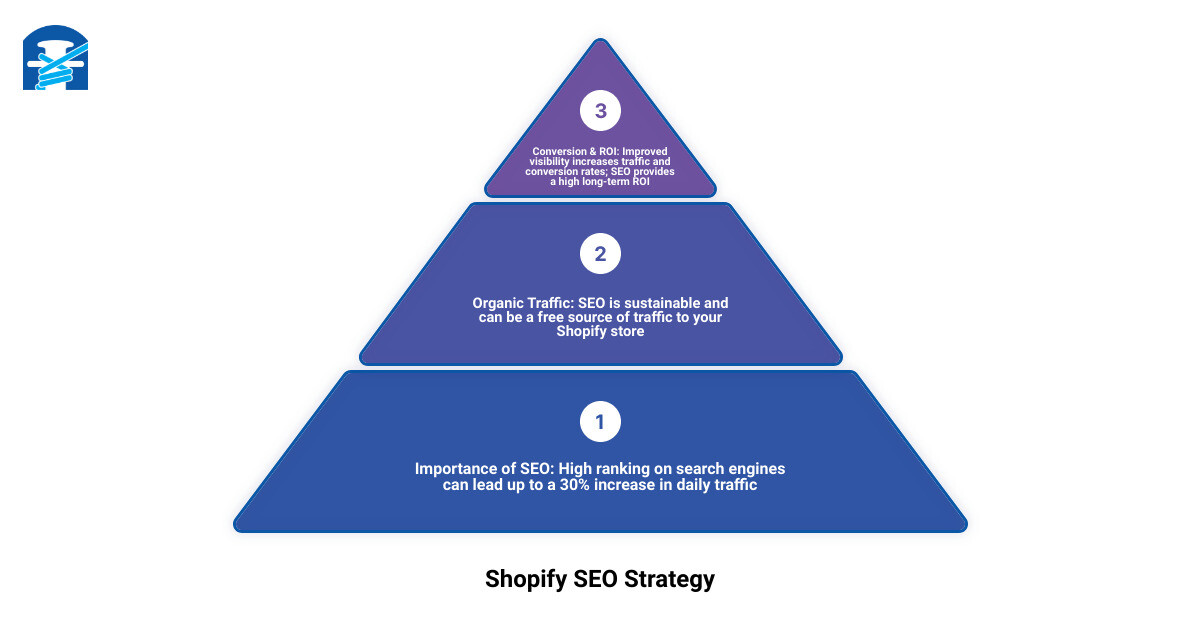
Understanding Shopify SEO: Built-in Features and Limitations
Unraveling the intricacies of Search Engine Optimization (SEO) can feel like navigating through a labyrinth. But with Shopify, a lot of the complexities are significantly simplified. As we delve into the built-in features and limitations of Shopify's SEO, you'll see why it's a favored choice for e-commerce businesses.
Shopify's Built-in SEO Features
At First Pier, we appreciate that Shopify was designed with SEO at its core. It comes equipped with a suite of built-in features that are instrumental in optimizing your content and improving your site's visibility.
One of these features is the automatic generation of canonical URL tags. These tags are crucial to prevent duplicate content from appearing in search results, a common issue that can negatively impact your site's rankings.
Shopify also automatically creates essential SEO files, namely your website's sitemap.xml and robots.txt files. These files help search engines understand the structure of your site and efficiently find your pages. The robots.txt file further guides search engine crawlers on which pages to crawl and index.
Another significant feature is the ability to manually edit title tags, meta descriptions, URLs, and image alt text. These elements play a pivotal role in on-page SEO as they help search engines understand what your pages are about, influencing your rankings for specific keywords.
Moreover, Shopify checks off several key technical SEO requirements. It automatically updates your sitemap, optimizes website speed, and ensures responsive design. With a majority of online shoppers now using their smartphones for shopping, having a mobile-friendly site is absolutely critical.
Limitations of Shopify's Built-in SEO
Despite these robust features, Shopify does have a few limitations that are important to acknowledge. The platform operates with a restricted platform that can be challenging to modify. This restriction can pose a challenge for users wanting to make backend modifications to enhance SEO value.
However, with continuous learning and adapting to the ever-changing SEO dynamics, these limitations can be overcome. Keyword research, on-page optimization, and link building are just a few additional strategies you can employ to effectively optimize your Shopify store for search engines.
In conclusion, Shopify's built-in SEO features provide a solid foundation. However, to truly master SEO, you'll need to understand the platform's limitations and how to overcome them. By coupling this understanding with the implementation of advanced SEO strategies, you can significantly boost your store's visibility, bringing you one step closer to unlocking your Shopify store's full potential.
In the following sections, we will provide a step-by-step guide to further optimize your Shopify SEO strategy. From technical SEO to content marketing, we'll cover all the bases to help you revolutionize your sales and unleash the full potential of your Shopify store. Stay tuned!
Developing a Custom Shopify SEO Strategy
If you want a high-performance online store that consistently ranks high on search engine results pages (SERPs), you need more than just the built-in SEO features that Shopify provides. Implementing a custom Shopify SEO strategy can be the game-changer your business needs to stand out in the crowded online marketplace and attract more organic traffic.
Importance of a Custom SEO Strategy for Shopify
A custom SEO strategy is an essential ingredient in the recipe for your Shopify store's success. Why? Because when you tailor your SEO tactics to match your brand's unique needs and goals, you're not just playing the SEO game—you're playing to win.
According to a study by Wolfgang Digital, as much as 35% of total traffic can come from search engine results, with a whopping 33% of revenue generated from this organic traffic. This means a well-executed custom SEO strategy can yield a tremendous return on your investment.
Moreover, with the escalating costs of paid advertising on platforms like Facebook and Instagram, SEO offers a sustainable source of "free traffic" that can provide long-term value and growth. It's not an immediate payoff, but the compounding effect of proper SEO makes it a valuable component of your marketing strategy, providing the best value for money channel to generate customers.
Key Elements of a Successful Shopify SEO Strategy
So, what does a successful custom Shopify SEO strategy look like? Here are some crucial elements you need to consider:
1. Site Structure and Technical SEO:
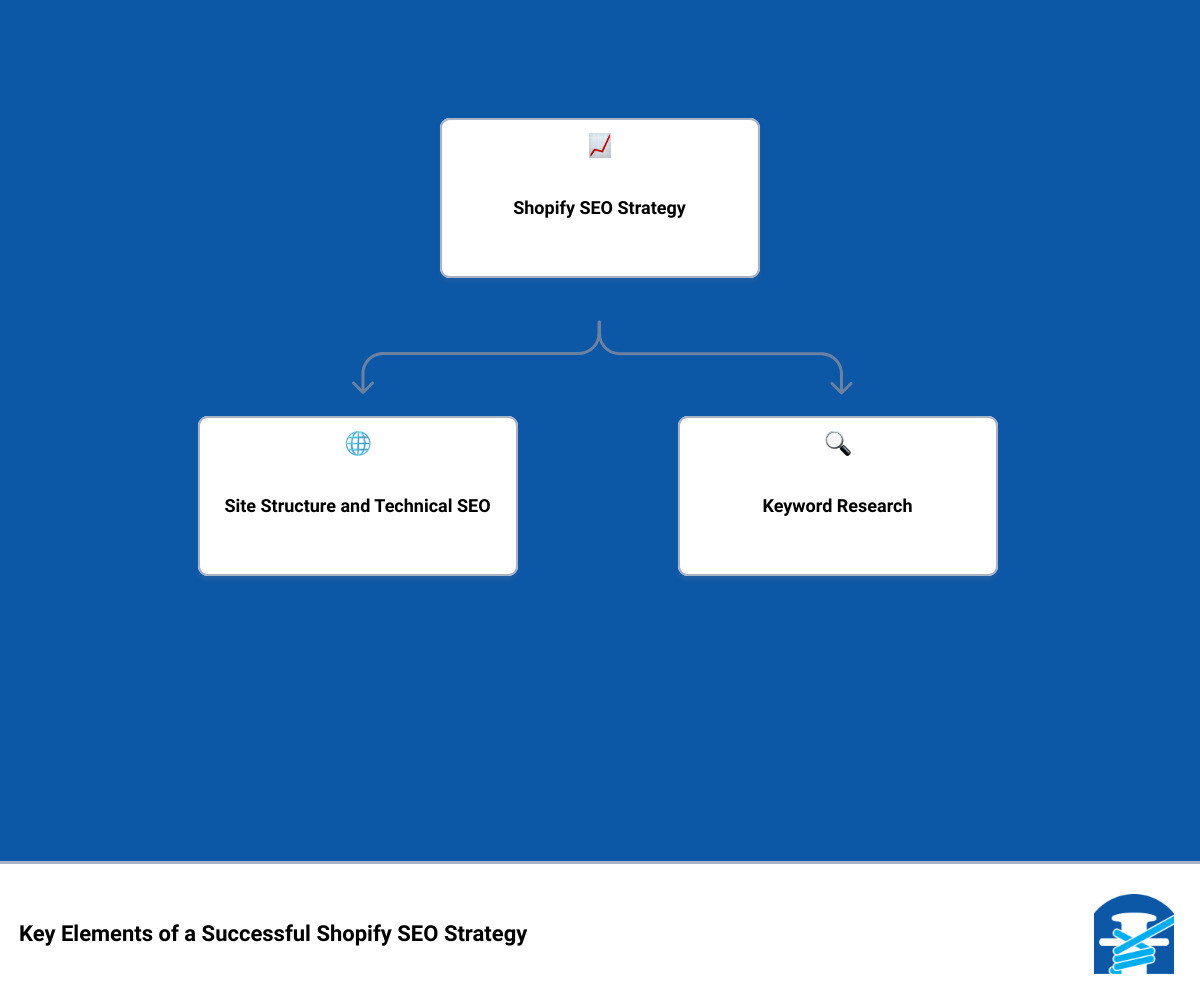 The structure of your Shopify store plays a significant role in your SEO strategy. A well-organized site is easier for search engines to crawl and index, improving your chances of a higher SERP ranking. Make sure your site loads quickly, as page speed is a major factor in SEO performance.
The structure of your Shopify store plays a significant role in your SEO strategy. A well-organized site is easier for search engines to crawl and index, improving your chances of a higher SERP ranking. Make sure your site loads quickly, as page speed is a major factor in SEO performance.
2. Keyword Research: Identifying and strategically using the right keywords can significantly enhance your SEO. This entails understanding what your target audience is searching for and incorporating those keywords into your content.
3. On-Page SEO: This involves optimizing individual pages on your website, including product descriptions, titles, and meta descriptions, to improve search engine visibility and user experience.
4. Content Marketing: High-quality, relevant content not only engages your audience but also signals to search engines that your site is a valuable resource. Consistently posting engaging content that integrates your chosen keywords can significantly boost your SEO.
5. Link Building: Both internal and external links play a vital role in your Shopify SEO strategy. They help to establish the relevance and authority of your site, which can lead to higher rankings in SERPs.
6. Utilizing SEO Tools: There are several Shopify SEO apps and tools available that can help you streamline and optimize your SEO efforts. These tools can help with everything from keyword research to on-page SEO and link building.
At First Pier, we understand that every business is unique, and there's no one-size-fits-all solution when it comes to SEO. That's why we tailor our strategies to your specific needs and goals, helping you optimize your Shopify store and drive sustainable growth. In the following sections, we'll delve deeper into each of these elements, providing you with a comprehensive guide to revolutionizing your Shopify SEO strategy.
Technical SEO for Shopify: Code Review and Optimization
When you're on a mission to maximize your Shopify store's visibility and growth, technical SEO becomes your secret weapon. At First Pier, we know that a thorough code review and optimization can drastically improve your site's performance, user experience, and ultimately, your bottom line. So, let's cut to the chase and explore why code review is crucial, how to conduct one, and the importance of speed optimization for your Shopify store.
Importance of Code Review and Optimization
In the world of SEO, success isn't solely about stuffing your content with keywords. It goes way beyond that. Our experience has shown us that a seamless and efficient site structure, driven by clean and optimized code, is a key factor in achieving high search engine rankings.
A meticulous code review is critical for identifying potential issues that could be hindering your site's performance. These could include broken links, unnecessarily complicated code, or even errors that prevent search engine bots from crawling your site effectively. By rectifying these issues, you’ll be paving the way for enhanced site performance and improved visibility in search engine results.
How to Conduct a Code Review for Shopify SEO
Conducting a code review might sound like a task for the tech-savvy, but with a systematic approach, it's achievable. First, check your site’s mobile responsiveness. Google favors sites that are mobile-friendly, so it's vital to ensure your store looks and functions flawlessly on all devices. You can use tools like Google's Mobile-Friendly Test for this.
Next, ensure your site is secure. Google and other search engines prioritize sites with SSL certification and HTTPS domains, as they provide a safer browsing experience for users. If your Shopify store isn’t secure, it's high time you change that.
Finally, make sure there are no broken links on your site. Broken links can lead to crawling errors and negatively impact your SEO. You can use Google Search Console to identify and fix any broken links on your site.
Shopify Speed Optimization: Why it Matters and How to Achieve it
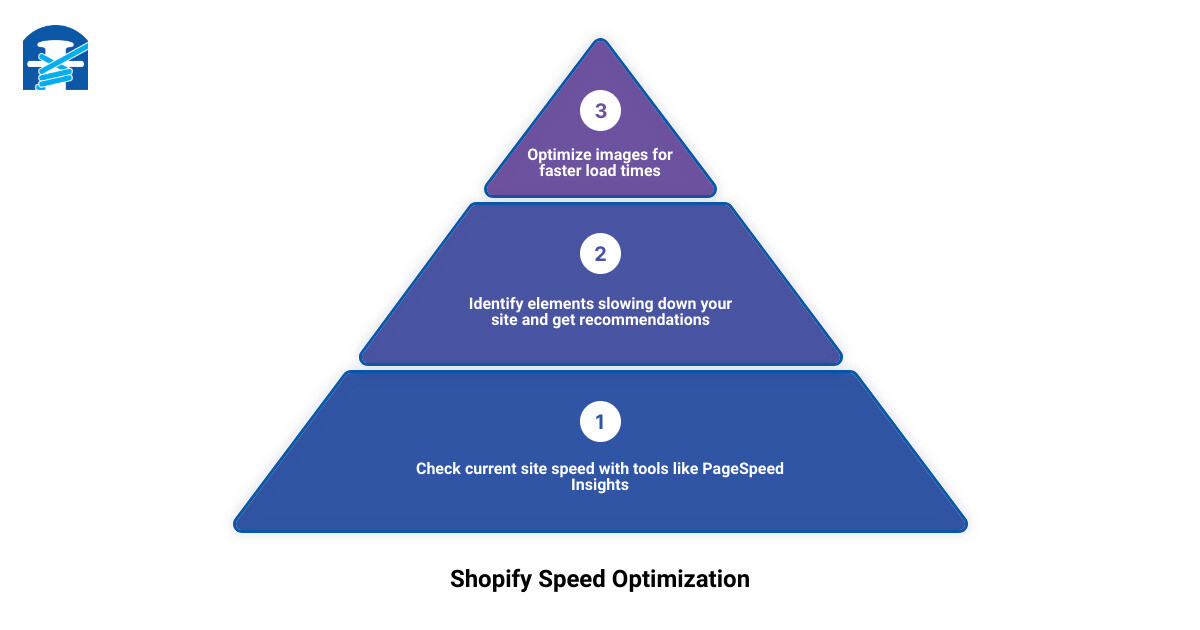
Slow site speed can be a major turnoff for visitors, leading to higher bounce rates and negatively impacting your search engine rankings. That's why at First Pier, we place a strong emphasis on speed optimization.
First, assess your current site speed using tools like PageSpeed Insights. This can give you insights into elements that are slowing down your site and provide recommendations for improvement.
Next, optimize your images. Large, unoptimized images can significantly slow down your site. Use smaller, optimized images to improve load times without compromising on quality.
Also, consider using a fast, mobile-friendly theme and removing any apps or features that you're not actively using. These steps can significantly speed up your site and improve user experience, ultimately boosting your Shopify SEO strategy.
Code review and site speed optimization may seem like small cogs in the large SEO machine. But, as we've seen, they play a crucial role in enhancing your site's performance and visibility. At First Pier, we're committed to helping you unlock the full potential of your Shopify store through comprehensive SEO strategies, tailored to your unique needs. Stay tuned for more insights on keyword research and product page optimization in our upcoming sections.
Keyword Research for Shopify SEO
The world of eCommerce is a competitive landscape, and in the race to the top of search engine results, keywords are your most powerful allies. A thorough understanding of keywords and their significance in Shopify SEO is crucial to driving organic traffic to your online store.
The Role of Keywords in Shopify SEO
As an integral part of SEO, keywords act as the bridge connecting your Shopify store to customers actively seeking the products you offer. Think of keywords as the language your potential customers speak when they're searching for products online. By optimizing your Shopify store with the right keywords, you're essentially learning this language, enabling your store to be more visible and accessible to your target audience.
A well-planned keyword strategy can greatly enhance your store's visibility on search engine results pages (SERPs), driving more traffic to your store. More traffic often equates to a higher probability of conversions and sales.
How to Conduct Effective Keyword Research for Your Shopify Store
Keyword research can seem daunting at first glance, but worry not, we are here to guide you through the process. The journey to effective keyword research begins by identifying main topics relevant to your products.
Start by listing at least five main topics that resonate with your customers and are closely related to your products. Step into your customers' shoes and think about the search terms they would use to find the products you sell. These topics could be inspired by your buyer personas, social media hashtags related to your products, or even the titles, meta descriptions, and image alt-text used on your competitors' sites.
But brainstorming is only part of the story. To expand your keyword list and unearth the search terms with the most potential, you can leverage keyword research tools. These tools can provide insights into the search volume, competitiveness, and relevance of your potential keywords.
Once you've identified a robust list of keywords, the next step is to incorporate them into your Shopify store strategically. Start by optimizing your top pages - your homepage, main product collections, and top-selling product pages. These are the pages that are the most profitable and have the best conversions.
When it comes to using keywords, remember that quality trumps quantity. Keywords should be woven naturally into your content, titles, meta descriptions, and product descriptions. For instance, a title could follow the format: "Keyword 1 – Shop for Keyword 2 – Store Name". So, if you're selling Unicorn T-shirts, your title could be "Unicorn T-shirts – Shop for Unicorn T-shirts Online – The Store."
Don't overlook smaller details like image alt text, which can also be optimized for SEO. Your chosen keywords should fit seamlessly into your content, sounding natural rather than forced. If they seem awkward, consider revisiting your keyword choices.
Conducting effective keyword research and utilizing them strategically in your Shopify store is a crucial step in your Shopify SEO journey. It forms the foundation of your SEO strategy, paving the way for increased visibility, traffic, and ultimately, sales. Stay tuned for more insights on optimizing your Shopify product pages for SEO in our upcoming sections.
The infographic below provides a step-by-step guide on how to conduct effective keyword research for your Shopify Store:
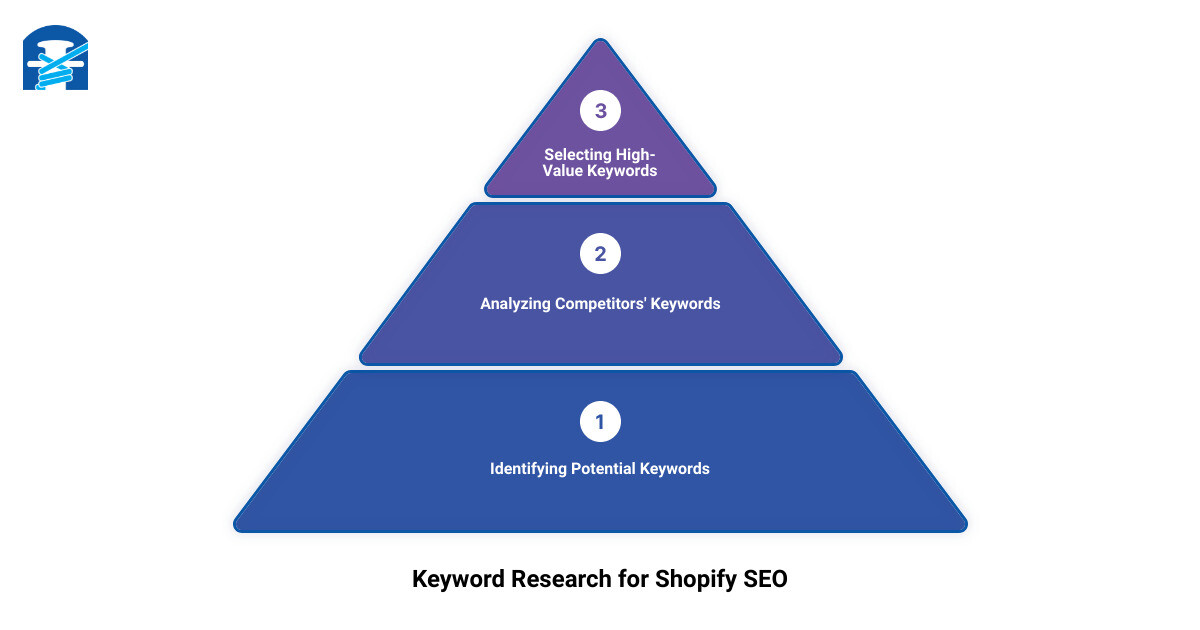
Optimizing Shopify Product Pages for SEO
Importance of Product Page Optimization
Have you ever walked into a shop and found it difficult to find what you're looking for due to clutter and poor organization? Frustrating, right? The same principle applies to your online store. Your Shopify product pages are the digital shelves of your online store, and ensuring they are well-optimized is crucial for your Shopify SEO strategy.
Every product page represents a unique opportunity to rank in search engine results for a specific set of keywords. Optimized product pages can attract more organic traffic to your store, increase visibility, and ultimately lead to more conversions and higher revenue.
Best Practices for Shopify Product Page SEO
So, how can you ensure your product pages are optimized for SEO success? Here are some best practices we follow at First Pier to give our clients' product pages the best chance to rank highly in search results.
Craft Compelling and Keyword-Rich Titles and Descriptions: Your product titles and descriptions should not only be rich in your chosen keywords but should also paint a vivid picture of your product. This combination of keyword optimization and compelling copy can increase both visibility on search engines and conversions.
Optimize Your Images: Images play a significant role in product pages. Ensure you optimize the alt text for your images, helping search engines understand the content of your images. Remember, search engines can't 'see' images like humans do, so accurate and descriptive alt text is essential. Also, consider the file size and format of your images. Shopify recommends using images in JPG or PNG formats and reducing the file size for faster loading times.
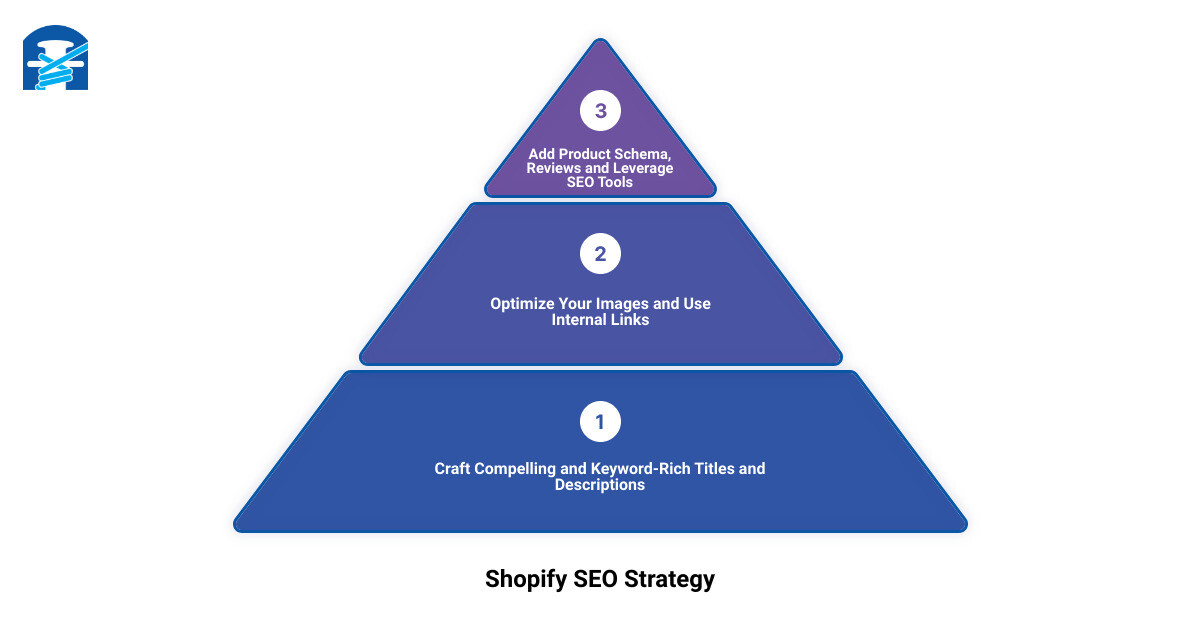
Use Internal Links: Linking to other relevant pages on your site from your product pages not only improves the overall navigability of your Shopify store but also boosts your SEO.
Add Product Schema and Reviews: Product schema provides search engines with more information about your products, while reviews can increase your click-through rates and boost your SEO.
Leverage Shopify SEO Apps or External Tools: Tools like Yoast SEO can analyze your content and provide suggestions for improvement, helping you create SEO-friendly product descriptions.
Remember, SEO isn't a one-time task; it requires constant monitoring and updating. Regularly review your product pages to ensure they continue to be relevant and optimized for search. By doing so, you can help your Shopify store stay ahead in the race and achieve lasting success.
In the next section, we'll delve into the role of link building in your Shopify SEO strategy. Stay tuned!
Building Links for Your Shopify Store
Just like a bustling metropolis relies on its well-connected roads and highways, a thriving Shopify store is marked by its robust network of links. It's all about creating pathways that guide potential customers and search engines directly to your virtual doorstep.
The Role of Link Building in Shopify SEO
Link building is the process of earning hyperlinks from other websites that point to your own. In the world of SEO, these links act like votes of confidence, indicating to search engines that your Shopify store is a credible and authoritative resource. High-quality links can notably enhance your website's visibility in search engine results, driving more organic traffic to your store.
But here's the catch: link building is not just about quantity, but also about the quality and relevance of the links. A handful of links from well-established and relevant websites can be more beneficial than a vast number of links from low-quality or unrelated sites.
Strategies for Internal and External Link Building
So how do you build these high-quality links to your Shopify store? At First Pier, we've identified several effective strategies:
-
Create High-Quality, Shareable Content: One of the simplest ways to naturally attract links is to generate top-notch content that others find valuable and worth sharing. This could include informative blog posts, detailed product guides, or engaging videos. Your content should not only be highly informative but also unique and engaging to encourage others to link to it.
-
Leverage Product Reviews: Product video reviews are a potent tool to attract potential customers. By creating these videos and uploading them to platforms like YouTube, you can reach potential customers who are actively seeking product reviews or comparisons. For instance, if you sell PRS guitars, a video review on "prs custom 24 se" can attract an estimated 500 monthly searches in the U.S.
-
Analyze Competitor Backlinks: One effective link building strategy is to replicate your competitors' common homepage links. Tools like Ahrefs' Link Intersect tool can help you identify these opportunities, providing a list of potential link-building opportunities.
-
Guest Posting: Guest posting involves writing articles for other websites or blogs in your niche. In return, you often get a link back to your Shopify store. This not only gives you a valuable backlink but also helps you reach a broader audience.
-
Broken Link Building: This white-hat SEO tactic involves finding broken links on other websites and suggesting your content as a replacement. This can earn you a high-quality backlink and is a win-win situation as it helps the website owner fix broken links on their site.
To sum up, link building is a critical SEO strategy that can significantly enhance the visibility and success of your Shopify store. By using these strategies, you can build a network of high-quality links that drive more traffic to your store and boost your search engine rankings. Up next, let's explore how you can leverage content marketing to further amplify your Shopify SEO. Stay tuned!
Leveraging Content Marketing for Shopify SEO
Why Content Marketing is Crucial for Shopify SEO

Content is king. This maxim holds true especially in the realm of SEO. In the bustling digital marketplace, it's not just about having the best products. It's about telling compelling stories, connecting with your audience, and providing valuable insights. This is why content marketing is a crucial part of your Shopify SEO strategy.
High-quality, relevant content not only resonates with your audience, but it also signals to search engines that your site is a valuable resource worth ranking high in search results. The more quality content you produce, the more opportunities you create to rank for keywords, earn backlinks, and build a loyal audience.
According to research from Shopify, online stores can expect 35% of total traffic to come from search engine results pages. Therefore, if you’re not creating content that matches your audience's search intent, you're missing out on a significant chunk of potential traffic and revenue.
How to Implement a Content Marketing Strategy for Your Shopify Store
Creating SEO-friendly content for your Shopify store involves more than just sprinkling keywords throughout your website. It requires a strategic approach, focused on delivering value to your audience and enhancing your site's visibility. Here at First Pier, we recommend the following strategies for implementing a successful content marketing strategy for your Shopify store:
-
Understand Your Audience: Know who your customers are and what they’re interested in. What questions do they have? What information are they searching for? Use this insight to guide your content creation efforts.
-
Create Quality Content: Quality trumps quantity when it comes to content marketing. Focus on creating content that provides value to your audience. This could be in the form of blog posts, videos, infographics, guides, or tutorials.
-
Use Keywords Strategically: Include relevant keywords in your content, but don’t overdo it. Your content should read naturally and offer value to the reader, not just serve as a vehicle for keyword stuffing.
-
Promote Your Content: After creating your content, make sure to promote it. Share it on your social media channels, email newsletters, and other marketing channels.
-
Monitor and Adjust: Use tools like Google Analytics to track the performance of your content. Are people reading it? Is it driving traffic to your site? Use this data to adjust your strategy as needed.
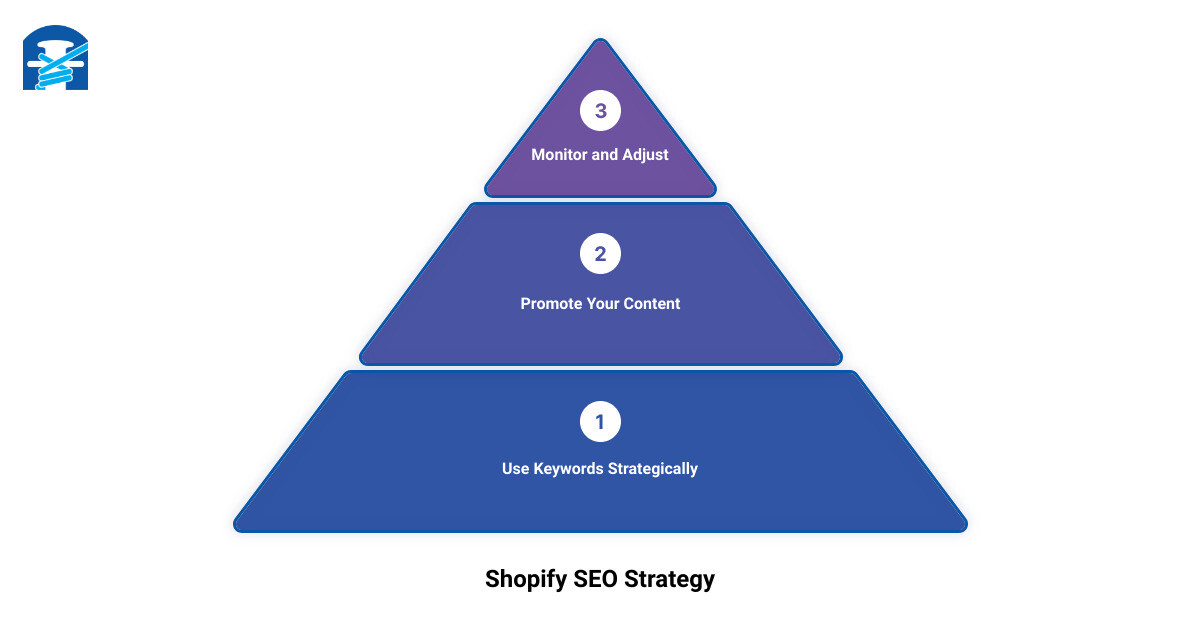
Content marketing is a long-term strategy, but the benefits are worth the effort. By consistently producing high-quality content that meets the needs of your audience, you'll improve your site’s SEO, attract more organic traffic, and ultimately, increase sales. In the next section, we'll delve into Shopify SEO apps and tools that can further enhance your SEO efforts. Stay tuned!
Utilizing Shopify SEO Apps and Tools
Overview of Shopify SEO Apps and Tools
Just like a seasoned sailor relies on his compass and maps, the success of your Shopify SEO strategy greatly depends on effective SEO apps and tools. These digital allies provide invaluable insights, automate tedious tasks, and help you optimize your online store like a pro.
Shopify's built-in SEO features are your first line of defense. They automatically handle essential tasks like adding auto-generated canonical tags to prevent duplicate content and generating your website's sitemap.xml and robots.txt files. You can also manually edit title tags, meta descriptions, URLs, and image alt text to align with SEO best practices.
But sometimes, you need a little extra artillery. That's where third-party Shopify SEO apps come to the rescue. Plugin SEO is a popular choice and for good reason. It offers keyword suggestions, meta content optimization, and broken link fixing. It also keeps up with the ever-evolving search engine algorithms, ensuring your store stays optimized.
Smart SEO is another robust tool that automates the process of generating meta tags and alt tags and automatically generates a sitemap for your store. It eliminates the need to manually enter meta tags or alt tags, saving you precious time.
Finally, don't forget SEO Image Optimizer. This handy app automatically adds and optimizes alt tags for your images, improving site load speed and making your images discoverable in search engine results.
How to Use Shopify SEO Apps and Tools for Maximum Benefit
Having these tools at hand is fantastic, but knowing how to use them effectively is the real game-changer. Here are some tips:
-
Keep a Close Eye on Metrics: Each SEO app provides valuable metrics that can help you understand your SEO performance. Make it a habit to check these metrics regularly and adjust your strategy accordingly.
-
Leverage Automation: These apps are designed to automate many tedious SEO tasks. Use this to your advantage. For instance, use Smart SEO to automatically generate meta tags and alt tags.
-
Stay Updated: SEO is an ever-evolving field. Make sure your apps are updated regularly to keep up with the changes in search engine algorithms.
-
Fix Errors Promptly: Many of these apps, like Plugin SEO, alert you to SEO issues in your store. Act on these alerts promptly to avoid damaging your SEO.
-
Optimize Images: Use the SEO Image Optimizer to ensure your images are not only attractive but also SEO-friendly.
By effectively utilizing these SEO apps and tools, you can supercharge your Shopify SEO strategy and propel your store to new levels of success. Remember, in the world of SEO, every small tweak makes a difference. So, start optimizing today!
As we wrap up our Shopify SEO exploration, keep in mind that SEO is not a one-time task but an ongoing process. With persistence, the right strategies, and a touch of SEO savvy, you can make your Shopify store stand out in the crowded online marketplace. So, don't wait. Boost your sales by optimizing your Shopify SEO today!
Conclusion: Maximizing Your Shopify SEO Strategy for Increased Sales
As we round up our discussion on Shopify SEO strategies, it's crucial to underscore the fundamental premise of SEO: it's not just about driving traffic to your site—it's about attracting the right traffic.
A successful SEO strategy starts with understanding your audience's search intent and optimizing your Shopify site structure accordingly. It includes meticulous keyword research to ensure your products and content match the queries your potential customers are using.
But it doesn't stop there.
Optimizing Shopify product pages is a critical step towards improving your visibility on search engines. By crafting compelling product descriptions, using high-quality images, and ensuring your meta tags, titles, and URLs are SEO-friendly, you can significantly enhance your product page SEO.
Furthermore, link building plays a pivotal role in your Shopify SEO strategy. Building a network of high-quality internal and external links not only strengthens your SEO but also enhances your site's user experience.

Don't underestimate the power of content marketing. High-quality, SEO-optimized blog posts, articles, and guides can significantly improve your rank in search results, driving organic traffic to your store.
Finally, leveraging Shopify SEO apps and tools can streamline your SEO process, making it more manageable and efficient. Tools like Yoast, SEMRush, and SEO Image Optimizer can provide valuable insights and help you optimize your site more effectively.
In the ever-evolving world of SEO, staying ahead of the curve requires continuous learning, adaptation, and improvement. It’s a marathon, not a sprint. But with persistence, the right strategies, and a touch of SEO savvy, you can make your Shopify store stand out in the crowded online marketplace.
At First Pier, we believe that every SEO tweak you make today is an investment in your store’s future success. Our team of Shopify experts is here to help you optimize your Shopify SEO, boost your visibility, and accelerate your sales.
So why wait? It's time to unleash your Shopify SEO strategy and revolutionize your sales. Remember, the journey of a thousand miles begins with a single step. Let's take that step together today!







